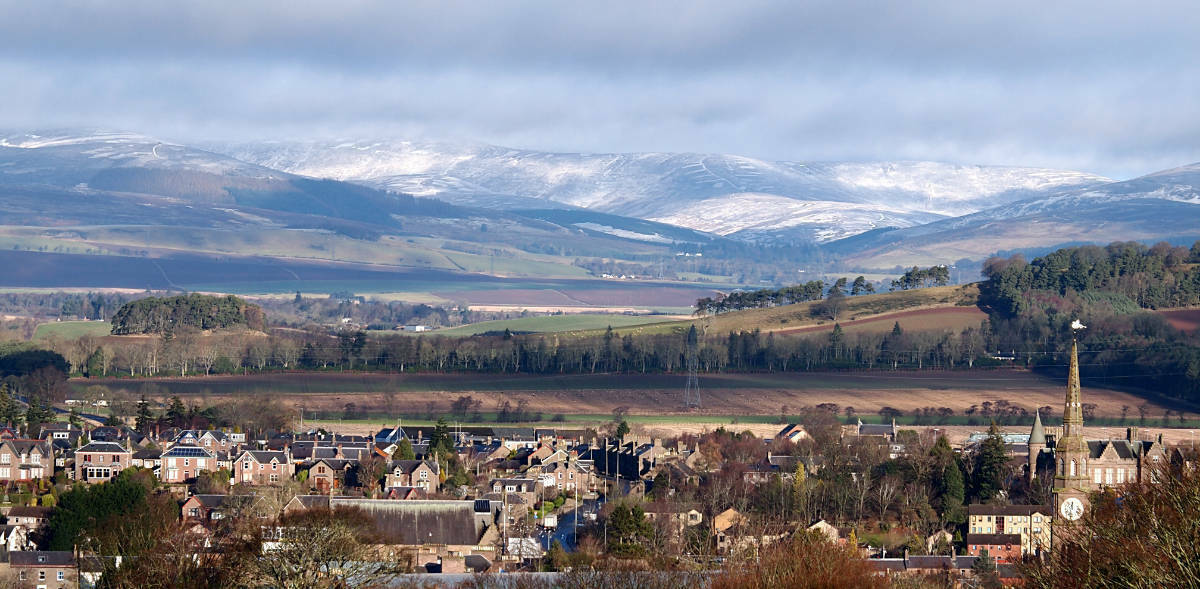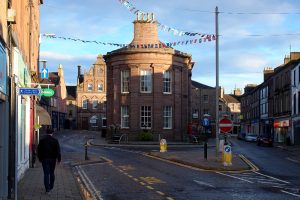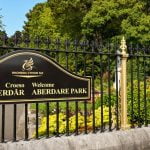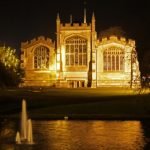
Forfar was formerly known as Angus, named after the county, that it sits in. It is a market town with an ancient history that has been committed to local legend. It is in the heart of the rural region known as the Valley of Strathmore. The Strathmore Glen is known for the Strathmore Springs which bring fresh bottled water to the masses.
There’s lots to learn about this wonderful little Angus market town. Let’s go all the way back to the beginning of Forfar history and find out more about it.
The Early History of Forfar
The Romans invaded Britain roundabout 40 AD. They came so far north and then they built a wall to keep out the Scots. In fact, they built two walls. The first is the better known Hadrian’s wall and the second is the Antonine wall. To put that into perspective, the tribes and clans of the Scots were so feared that they kept them out not once, but twice.
The Antonine Wall[i] would have run between Glasgow and Edinburgh and kept everything north of the border where it should be. Nevertheless, the Romans still tried occasionally to take over Scotland. It is because they tried to foray into Forfar that we know that there was a settlement here during Roman times.
There was a Roman camp known as Battledykes, which would have sat about 3 miles north of Forfar. The camp held anything up to 60,000 Roman soldiers. There are numerous other camps to the north, all of which were erected during that foray. The Romans Record that they invaded this area 4 separate times between 83 AD and 306 AD. Their records report a castle at Forfar from 300 and 680 onwards. There is also a small village that grew up in the shelter of the castle.
Clan Guthrie
Records show that the town of Angus (Forfar) belonged to Clan Guthrie. They were the owners of the castle. Clan Guthrie may have their roots in Viking blood. It is thought that Guthrie might be a shortened version of Guthrum, the Viking name. The name lends itself to the barony for the castle that was erected. The Laird of Guthrie accompanied Sir William Wallace back to Scotland from France in 1299. Clan Guthrie was there for the Battle of Flodden in 1513. It was the 20th chief of the Guthrie clan who commanded the 4th Battalion of the Black Watch in WWII. For every battle fought in Scotland, the Guthries have played a part… but let’s move on.
Forfar was the site of a pitched battle between the Angles and the Picts in 685 AD. This was known as the Battle of Dunnichen… no pun intended (do-not-ken (Do-not-know))
Forfar during the Middle Ages
Forfar was given Royal borough status in the 12th century by King David, the first of Scotland. The Charter was then restated by Charles the 2nd in 1665. King Malcolm’s Queen, Margaret, established a Chapel here. And the castle which sat at Forfar supposedly held two sessions of the Scottish Parliament in the 1100s[ii].
During the first Scottish War of Independence, Forfar castle was overtaken by the English. It was used as a place from where they could police the local population. Robert the Bruce beat the Earl of Buchan at the Battle of Inverurie in 1308 and advanced on Forfar. In the dead of night, they used ladders against the wall, climbed over, surprised the Garrison, and slaughtered them. The controlling party was Phillip, the forester of Platane. He yielded the castle to Bruce. It was Robert the Bruce that demanded the castle be reduced to nothing.
Let us leave the medieval life of Forfar with an ominous thought. The women native to Forfar are the descendants of the women that were not burned for witchcraft in the 1700s. Forfar developed a reputation for witch trials, with numerous areas around the town still named after the witches they tried there. 18 witches were tried here – that we know about. A very clever young woman from the University of Edinburgh documented the recorded places of residence of accused witches as per the records.
You can check the map for yourself and learn about these women… of what little there is to know. There are even some members of Clan Guthrie in there. It was a terrifying time to be a woman. A total of 3,141 Scots women were tried. Most of the time, what happened to them after the trial is not even recorded. In the case of Forfar, cruel torture devices are still housed in the museum, and the Witches’ Hollow to the north is where they were executed.
And the Salem witch trials involved 14 women and 5 men.
Let’s talk about some fun facts for a while because that was a little harrowing.
Fun Facts and Trivia about Forfar
Every time we review a town here at Five Minutes Spare, we like to find a bit of gossip. Here is all the fun trivia we could find out about Forfar in one place, for your amusement:
- Something cheery for you to start with. A claimant to the throne of Duncan II had her brains dashed out at the Forfar Market Cross in 1230. She was still a baby. She was the daughter of the leader.
- Glamis Castle is only 5 miles away. You might wonder why you know that name. It’s because it’s in Shakespeare. Macbeth was Thane of Glamis and Cawdor too. The castle there is the historic seat of the Bowes-Lyon family. It’s the ancestral home of Her Majesty Queen Elizabeth, the queen’s mother.
- Forfar is thought to be one of Scotland’s oldest towns, although it’s difficult to tell because there isn’t a lot of recorded written history from the early days.
- Forfar had its heyday during the time of King Malcolm the first of Scotland back in the 1100s, he used the town as his preferred seat and even held parliament there.
- Two big parts of modern Forfar’s economy are bottled water and potatoes. Many of the town’s occupants work for the bottled water plant in the valley.
- Interesting side note, the small village of Zora on the outskirts of Forfar is the only village in Scotland that begins with the letter Z.
That seems to be quite enough interesting points of gossip for one day. Let’s get back to the Industrial Age and see how Forfar grew next.
Industrial Era Forfar
During the industrial era, the town was truly properly planned out. The county buildings were in Castle Street and exist since the mid-19th century. Most of the town was built in 1843 around the existing new prison. In the 18th century, Forfar still had thatched roof houses that were dirty and tended to start fires. These were all rebuilt during the early 1900s.
Industrial Era Forfar wasn’t as prosperous as its neighbouring big towns of Arbroath or of Dundee or Montrose. They had a thriving weaving industry and linen was made here as well as jute, which would be used in the sailing ships. Shoes, gloves, and clothing were all made within Forfar during that time. Towards the end of the 19th century, banks and insurance offices began to open. Rural fairs would still run a couple of times a year.
Keep in mind that all of this was happening within 200 years of the time when we were burning women as witches. It seems that we went through an awful lot of evolution in such a short period of time.
Rock Anyone?
Forfar rock became popular in the 19th century. This was a type of confectionery that melted in the mouth. The man who invented Forfar rock was a man named Peter Reid and he built Reid Hall, which is a beautiful old Manor house on the outskirts of town[iii]. You can still visit it to this day. We will cover this shortly with the other attractions.
The Provost Meffan’s daughter built the Meffan Museum in 1898 in the centre of town. It has an exhibit called the Forfar story. It acts as a meeting place for speakers and has an art gallery and summer clubs for the children. The story of Forfar tells you the history of the fantastic shoemakers who used to be here. It also tells the story of the burning of the witch, Helen Guthrie. You maybe want to leave the small kids at home for that one.
A large Class 1 Pictish stone was found in the fields nearby. A farmer from the east mains of Dunnichen, found it in the 19th century while he was ploughing his field. The carving of the Rose is incredibly rare. It was removed from the field and taken to a local church but was moved to the Dundee Museum in 1972. It has been brought to the Meffan Institute for a long-term loan. Where it is displayed alongside the Kirriemuir sculptured stones. There was also a canoe that was found in Forfar Loch in the 11th century, which is on display.
One of the biggest producers of textiles in the town during the 18th century was William Don & Co. They sold linen which would go on to be used in weaving in the local cottages. They had a weaving shed of their own as well. They merged with a Dundee firm named AJ Buist in 1865.
Together they built Saint James works in Forfar. They operated in Dundee and built the station works in Forfar. Together they had over 300 looms. Don Brothers built workers’ homes and by the 1980s, the Don and Low group, as it is now known, became the UK’s biggest polypropylene textile extrusion and weaving unit. The firm still operates out of Forfar to this day. It produces woven and non-woven polypropylene textile products.
Try saying that with your mouth full.
2oth Century Forfar
By 1911 20% of all the employees in Forfar worked in Jute. Dundee was the centre of the British Jute industry, with more than 40% of their working population involved in its production. By 1951 that had fallen to 18.5%. However, in Forfar, the percentage of the workforce had risen from 20% to 24% by 1951.
The Queen and the Duke of Edinburgh visited the town in 2004 and in 2011. HRH Prince Charles, the Duke of Rothesay, visited in 2012 to make a salute to the Black Watch. The Black Watch are one of the most famous regiments in Scotland. Renowned for bravery and have been present in every one of the world wars and just about every skirmish since[iv].
The Forfar Yeomanry saw action in the Boer Wars, the First World War, and the Second World War. They amalgamated with the Scottish horse. Although Operation Forfar was part of the Second World War, this was nothing to do with the town. It featured a series of British commando raids on the French coast. You can read more about Forfar in World War One and two in the wartime memories project.
Modern-day Forfar has the same feeling to it as modern-day Lanark and modern-day Ayr. All three places were places where William Wallace walked the earth, where Robert the Bruce fought and where castles were erected and dismantled all before, we were born. It’s steeped in a rich history that you must digest in small chunks to try and understand. It’s an excellent place to visit, particularly for hikers and walkers. The valley is stunning, and so is the town. Now let’s talk about the famous people from Forfar before we move on to the things you can see and do there.
Famous People from Forfar
There have been a few famous people to come from the mean streets of Forfar over the years. Some of our favourites are as follows:
- Numerous footballers, including Mike Adamson, Willie Brown, and Graeme Forbes.
- The author Peter Calder
- The first woman elected to the Royal College of Surgeons, was Caroline Doig. It’s no surprise it took until now since they were still burning women in Scotland as late as the 1700s. No. We are not going to let that one go.
- Female Scottish architect Kathryn Findlay.
- The botanist Helena M. L. Forbes
- Catherine Hollingworth was a Forfar woman, and she was a pioneer in child drama.
- And let’s not forget the painter, James Irvine.
OK, so they’re not people you are likely to meet in the fish aisle at Sainsbury’s, but Forfar still has a bunch of famous faces to call its own. Let’s move on to the part you have all been waiting for… the attractions.
Things to see and do in Forfar

Image: Janusz Baczynski/Shutterstock.com
If you are trying to choose a staycation for the next holiday season, consider a trip to Forfar. It’s pleasant, leafy, and perched on the edge of a beautiful valley. What more could you want?
Historic Sights and Landmarks
You could climb up Balmashanner Hill to see the tower that crowns it. This is a pleasant area of hiking and gardens made prominent by the monument at the top. It was built in 1921 and commemorates those that died during the first world war. Be prepared for a walk, although it is beautiful up there.
You can head out of town to the picturesque scenery found at Balgavies Loch. There’s an old Railway Signal Station around there, see if you can explore and find it. This is an attraction in the summer when retreating shores reveal a cool little beach. It does get busy on sunny weekends so make sure you arrive early to get a good space. It should go without saying but watch out for kids near lochs. They should be treated as you would treat a reservoir. It is run by the Scottish Wildlife Trust so take your bird-spotting binoculars and take your rubbish home with you.
Galleries and Museums
The only real museum in town is the Meffan Museum and Art Gallery. This place has carved stones, Roman goods, and evidence of the history of Forfar. It is the same institute that was set up in the Industrial Era by the Provost’s daughter, to record the history of the town for posterity. Go browse the artwork in the attached gallery or enjoy the local history.
If you are looking to trace your ancestry in this area, check out the Angus Archives. They have done their best to document the family histories of the area, and to record the Highland populations, residencies, etc. The archive is a wealth of historical archives for Scotland and beyond.
Outdoor Attractions
One of the biggest places to roam near Forfar is in the Crombie Country Park. This area holds 200 acres of woodland, with 7km of trails throughout. Take the kids here to explore, adventure, and learn about nature. Watch the foxes, badgers, and hunt for peregrine falcons and red squirrels. The country parks in Scotland are wild, so watch the edges of the water if you have little ones.
If that wasn’t enough wilderness for you, head to the Redwings Mountains reserve, instead. They have 220 acres of meadow and paddock for their 90 horses, ponies, and donkeys. Please don’t feed the animals without the express attention of an instructor. Pet the animals, learn about the differences between them or go on a trek. Booking in advance is essential since Covid.
Lastly in our outdoor attractions section, check out the beautiful gardens at Pitmuies. It takes years of training and intense preparation to make a lawn as green as they have. Browse the flower beds or enjoy the history of the first house built here in the 1500s. It’s described as the town’s hidden gem.
Sports and Recreation
You can take a few holes at Forfar Golf Club while you are in town if that is your sport of choice. There is a Forfar Driving Range, too, and several other clubs within a stone’s throw if you need more choice.
The local football team are known as Forfar Athletic FC and you can find them at Station Park. Although the town doesn’t attract huge numbers of fans, partly because there is no train station to accommodate them. The team do well enough.
Shopping and Retail
Other Notable Forfar Attractions
If you have made it this far, you must be spending more than the odd trip to Forfar here. Let’s talk about other things to see and do in and around Forfar for those that are more than just passing through.
Things to do in Forfar include:
- Visit the Murton Trust Nature Reserve just outside of town. They have an excellent little tea shop with plenty of home baking.
- Hiking Routes – one of the main attractions of Forfar is its location on the edge of the valley. Every year, it attracts plenty of hikers and campers through its hills and mountains. Be safe, take precautions, go prepared, and don’t go hiking in winter if you can possibly help it. We’re still looking for the last lot that never came back. You have been warned…
How to get to Forfar?
Now you are up to speed on all we know about Forfar – except how you go about getting there. Here’s how you can get there using our loose directions.
By Road
Forfar is off the A90 so straight north out of Edinburgh.
On The Train
Forfar train station closed in 1967. The nearest one today is Monifieth and there is a fairly regular bus service from there.
By Air
Dundee Airport is the nearest international airport but you might have limited flights, so Edinburgh is probably a better bet.
By Sea
Dundee is the nearest port if you really have to travel by boat.
Got Five Minutes?
If you have come this far, that must mean you really enjoyed the article. You can follow us on Facebook to keep up to date with all things Five Minutes Spare. You can also find plenty of other travel guides on our website.
[i] https://en.wikipedia.org/wiki/Antonine_Wall
[ii] https://maps.nls.uk/townplans/background/forfar.html
[iii] https://www.scotland.com/regions/angus-and-dundee/forfar/


